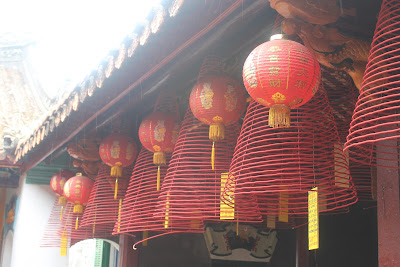Hoi An's Old Town contains over 800 historical buildings that are safeguarded by UNESCO decree. Many of these historic buildings are open for tourists, even homes still occupied by families. We visited a handful of the historic sites:
First, the Japanese Covered Bridge, constructed in the 1590's to connect the Japanese community with the Chinese quarters across the stream:

The entrance to the bridge is guarded by monkeys on one side and dogs on the other (stories differ as to the reasons behind that):
Next, we headed to the Tan Ky house, a two-centuries old merchant's house, preserved through 7 generations of the same family (who still live there, though mostly in the upstairs). The guide told us that all of the elaborate ornamentation and furniture we saw on the first floor of the house gets lifted, via a pulley system, to the second story each year when Hoi An floods... originally the pulleys were used by the merchants for moving goods in and out of storage.
This photo on the left shows the high water mark for each of the major recent floods, including in 1964, 2007 and 2011:
150 year old panels displaying Chinese poetry with inlaid mother-of-pearl birds forming the characters:

The house is long and narrow, and backs onto the river for easy movement of goods, but it has a courtyard in the center which lets in light, provides ventilation, collects rainwater and provides drainage:
After Tan Ky, we went to the Assembly Hall of the Fujian Chinese Congregation. The Chinese who settled in Hoi An identified themselves according to their province of origin, and each of these communities built its own assembly hall for gatherings, meetings and celebrations. This assembly hall was eventually turned into a temple for worshiping Thien Hau, a deity from Fujian province.
Tim and I loved the massive displays of smoking incense coils all over the temple:
Sweaty.
Cool mosaic dragon sculpture:

We hit up a couple other historic sites, including family temples and a handicraft workshop where the silk lanterns were being made, but the 3 above were the most picturesque.

















No comments:
Post a Comment
Note: Only a member of this blog may post a comment.